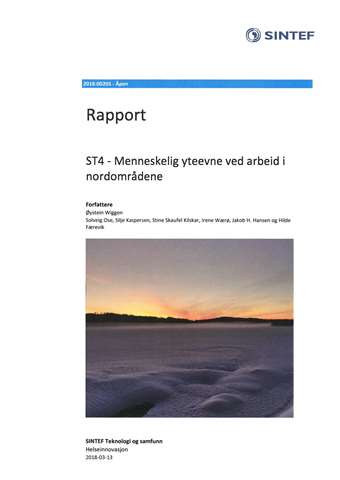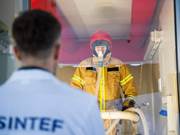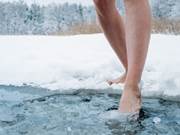ST4 - Menneskelig yteevne ved arbeid i nordområdene

- Authors
- Øystein Wiggen
- Solveig Osborg Ose
- Silje Lill Kaspersen
- Stine Skaufel Kilskar
- Irene Wærø
- Jakob Hønborg Hansen
- Hilde Færevik
- Year
- 2018

Utvikling av denne jakken er en del av ColdWear-prosjektet, som SINTEF har drevet siden 2008. I prosjektet er det framskaffet fysiologiske data på hvordan ekstreme temperaturer påvirker menneskets yteevne gjennom forsøk i et klimakammer. Nå brukes kunnskapen til å utvikle nye produkter – deriblant...
Not everyone pulls a nine-to-fiver within the confines of an office cubicle. “Roughnecks,” for instance, regularly brave below-freezing temperatures in the Arctic in pursuit of oil and natural gas. To help these workers cope with their hostile environment, Norwegian scientists are developing a line...
The cold and harsh climate in the High North represents a threat to safety and work performance. The aim of this study was to show that sensors integrated in clothing can provide information that can improve decision support for workers in cold climate without disturbing the user. Here, a wireless...
Fish farming is considered as a physical demanding occupation, including work operations with high workloads and awkward work positions for prolonged periods of time. Combined with potential challenging environmental conditions, these factors may negatively affect work performance, comfort and...
Several professions in industries, such as petroleum, manufacturing, construction, mining, and forestry require prolonged work tasks in awkward postures, increasing workers’ risks for musculoskeletal pain and injury. Therefore, we developed and validated a rule-based model for classifying unilateral...

...temperatures? It is wise to be well prepared in case an accident happens when you are out in the cold. Photo: Øystein Wiggen/SINTEF Standard Gemini has been quizzing doctor Sigurd Mydske and Øystein Wiggen, who is a research scientist at SINTEF and a cold temperature physiologist, all about what you need to...
Ambient temperature can affect physical performance, and an ambient temperature range of −4 °C to 11 °C is optimal for endurance performance in male athletes. The few similar studies of female athletes appear to have found differences in response to cold between the genders. This study investigated...

...potential of new technologies for building a safer working environment. Scientific Publications Svein O Tjosvoll, Trine M Seeberg, Marius S Fimland, Øystein Wiggen, Silje E Jahren. Classification of kneeling and squatting in workers wearing protective equipment: development and validation of a rule-based model...

Evaluation of personal protective equipment Validation of health technology solutions Manikin for evaluation of insulation in clothing Contact person: Øystein Wiggen Visiting Address: Prof. Brochs gate 2 Miljøbygget/Teknobyen NO-7030 Trondheim Postal Address: SINTEF Digital Dept. of Health Research P.O. Box...
... Purpose: To investigate differences in double-poling (DP) endurance performance, economy, and peak oxygen uptake (V̇O2peak) at low (–15°C) and moderate (6°C) ambient temperatures (TA) in cross-country skiers wearing standard racing suits. Methods: Thirteen well-trained male cross...
This study compared the effects of cold (−14° C) and moderate environments (6° C) on double poling (DP) sprint performance. Wearing modern cross-country ski racing suits, 14 highly trained male cross-country skiers performed a test protocol on a DP ergometer, consisting of a standardized warm-up...
Prolonged exposure to cold can impair manual performance, which in turn can affect work task performance. We investigated whether mild whole-body cold stress would affect isometric force control during submaximal hand grip and key pinch tasks. Twelve male participants performed isometric hand grip...
Use of cold-weather personal protective clothing (PPC) in cold climates is essential but can add metabolic cost to the wearer. This study measured the effect of wearing state-of-the-art PPC and personal protective equipment (PPE), with the possible effect of clothing layers and fit, on physiological...
This study investigated the usefulness of continuous sensor data for improving occupational cold stress assessment. Eleven volunteer male subjects completed a 90–120-min protocol in cold environments, consisting of rest, moderate and hard work. Biomedical data were measured using a smart jacket with...
Firefighters run a risk of heat strain during occupational tasks. The number of female firefighters has been increasing, but research relevant to this group is still scarce. We aimed to investigate whether there are any sex differences in heat tolerance or physiological responses during...
Objective: The objective of this study was to investigate how night work at low ambient temperatures affects cognitive performance (short-term memory and reaction time), skin- and core temperature, thermal comfort, sleepiness, and cortisol. We hypothesized that cognitive performance is reduced at...

...researchers have to say about the effects of cold on our bodies? Gemini invited SINTEF research scientist, physiologist and low temperature expert Øystein Wiggen to share his knowledge about the cold. “What do we know really about the health effects of cold bathing?” “Significantly more research has been...
Petroleum operations in the Barents Sea require personal protective clothing (PPC) to ensure the safety and performance of the workers. This paper describes the accomplishment of a user-centred design process of new PPC for offshore workers operating in this area. The user-centred design process was...